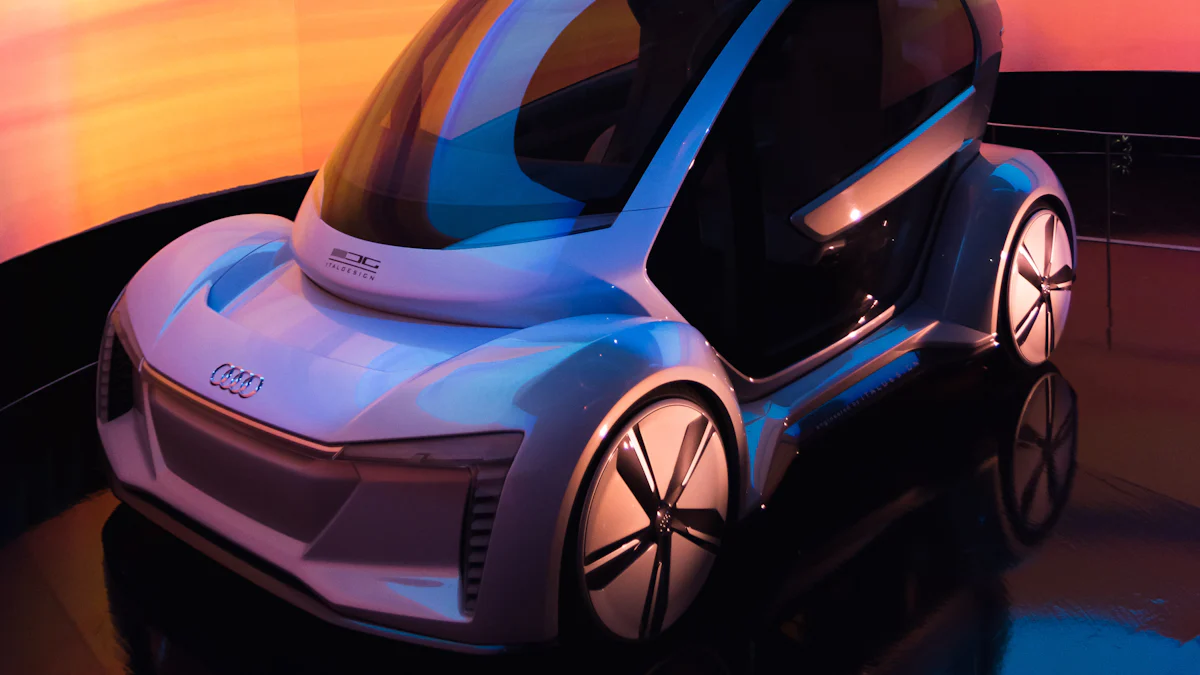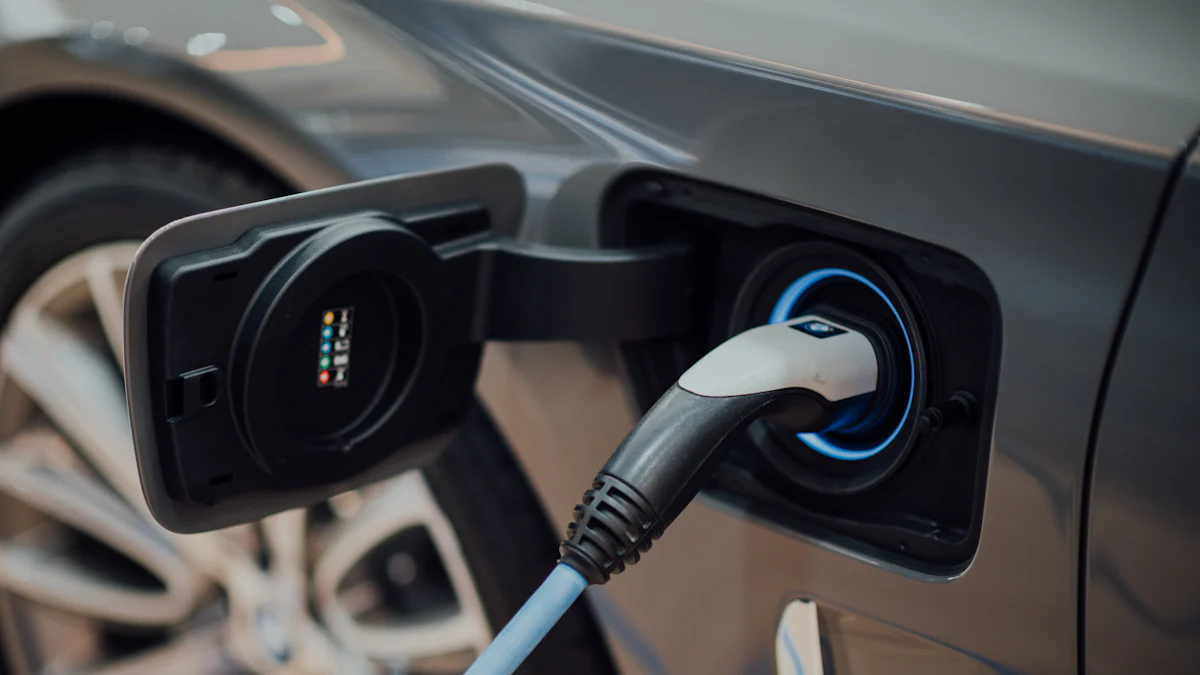2024 Automotive Trends: A Comprehensive Guide

The year 2024 marks a pivotal moment for the automotive industry. Rapid advancements in technology and significant changes in market dynamics will reshape the landscape. Staying updated with these automotive trends is crucial for industry professionals and enthusiasts alike. The automotive parts market expects aggressive growth, driven by rising demand for replacement parts and increased vehicle production. Additionally, digital marketing spending in the automotive sector continues to climb, reflecting the industry's adaptation to modern consumer behaviors.
Technological Advancements in Automotive Trends
Autonomous Driving
Level 4 and 5 Autonomy
Level 4 and 5 autonomy represent the pinnacle of self-driving technology. These levels enable vehicles to operate without human intervention under specific conditions or in all environments, respectively. Recent advancements in transformer models have significantly enhanced perception performance in autonomous driving systems. This improvement allows vehicles to better understand and navigate their surroundings. The potential for revolutionizing transportation through these advancements is immense. Autonomous vehicles promise to improve road safety and offer new mobility solutions.
Regulatory Challenges
Regulatory challenges remain a significant hurdle for the widespread adoption of autonomous vehicles. Governments and regulatory bodies must establish comprehensive frameworks to ensure safety and reliability. These frameworks need to address liability issues, data privacy concerns, and cybersecurity threats. The integration of 5G-V2X technology plays a crucial role in enabling rapid decision-making and high-speed connectivity. Real-time environmental data processing is essential for the safe operation of autonomous vehicles. However, regulatory approval processes can be lengthy and complex, delaying the deployment of these advanced systems.
Artificial Intelligence and Machine Learning
Predictive Maintenance
Artificial intelligence and machine learning are transforming predictive maintenance in the automotive industry. These technologies analyze vast amounts of data to predict potential vehicle failures before they occur. This proactive approach reduces downtime and maintenance costs. Machine learning algorithms continuously improve their accuracy by learning from historical data. Predictive maintenance enhances vehicle reliability and extends the lifespan of automotive components. The implementation of AI-driven maintenance systems represents a significant shift in automotive trends.
Enhanced Driver Assistance Systems
Enhanced driver assistance systems (ADAS) leverage artificial intelligence to provide advanced safety features. These systems include collision avoidance, lane-keeping assistance, and adaptive cruise control. AI algorithms process real-time data from sensors and cameras to make split-second decisions. The integration of machine learning enhances the performance of ADAS by adapting to different driving conditions. These advancements contribute to safer driving experiences and reduce the likelihood of accidents. The continuous improvement of AI and machine learning technologies will further enhance the capabilities of driver assistance systems.
Connectivity in Automotive Trends
Vehicle-to-Everything (V2X) Communication
Safety Improvements
Vehicle-to-Everything (V2X) communication enhances safety by enabling vehicles to interact with each other and surrounding infrastructure. This technology allows cars to share real-time data about road conditions, traffic signals, and potential hazards. The exchange of information helps prevent accidents and improves overall road safety. V2X communication supports advanced driver assistance systems (ADAS) by providing timely alerts and facilitating better decision-making. The integration of V2X technology represents a significant shift in automotive trends, promoting safer driving environments.
Traffic Management
V2X communication plays a crucial role in traffic management by optimizing the flow of vehicles on the road. This technology enables vehicles to communicate with traffic lights, road signs, and other infrastructure elements. The exchange of real-time data helps reduce congestion and improve traffic efficiency. V2X communication allows for dynamic traffic signal adjustments based on current traffic conditions. This capability leads to smoother traffic flow and reduced travel times. The implementation of V2X technology aligns with the evolving automotive trends focused on enhancing urban mobility solutions.
5G Integration
Real-time Data Processing
The integration of 5G technology in vehicles revolutionizes real-time data processing capabilities. 5G networks offer high-speed, low-latency connectivity, enabling vehicles to process vast amounts of data quickly. This capability is essential for autonomous driving systems that rely on real-time environmental data. The use of 5G-V2X technology enhances the performance of autonomous vehicles by providing reliable communication channels. The ability to transmit high-volume sensor data from LiDAR and HD cameras ensures accurate decision-making. The adoption of 5G technology represents a pivotal development in automotive trends, supporting the advancement of connected and autonomous vehicles.
Enhanced Infotainment Systems
5G integration also transforms infotainment systems in modern vehicles. The high bandwidth and low latency of 5G networks enable seamless streaming of high-definition content. Passengers can enjoy real-time entertainment options, including video streaming and online gaming. The integration of 5G technology supports advanced navigation systems with real-time traffic updates and location-based services. Enhanced infotainment systems contribute to a more enjoyable and connected driving experience. The incorporation of 5G technology into vehicle infotainment systems reflects the ongoing evolution of automotive trends towards digital and connected experiences.
Electric Vehicles (EVs)

Battery Technology
Solid-State Batteries
Solid-state batteries represent a significant advancement in electric vehicle technology. These batteries use solid electrolytes instead of liquid ones, which enhances safety and energy density. The automotive industry anticipates that solid-state batteries will offer longer driving ranges and shorter charging times. Manufacturers continue to innovate with new battery pack configurations, such as cell-to-pack and cell-to-chassis designs. These configurations improve the overall performance and efficiency of electric vehicles. The adoption of solid-state batteries will likely accelerate the transition to electric mobility.
Fast Charging Solutions
Fast charging solutions are crucial for the widespread adoption of electric vehicles. Recent trends show a shift towards electric vehicles, plug-in hybrid vehicles, and fuel cell electric vehicles. Governments around the world focus on expanding charging networks to support the growing EV fleet. Innovations in manufacturing, such as multi-layer electrodes, enable ultra-fast charging capabilities. These advancements reduce the time required to recharge electric vehicles, making them more convenient for consumers. The development of fast charging solutions aligns with the increasing demand for electric vehicles.
Market Expansion
Emerging Markets
Emerging markets play a vital role in the expansion of the electric vehicle market. Countries in Asia, Africa, and Latin America show significant potential for growth in EV adoption. These regions experience rapid urbanization and increased environmental awareness. As a result, consumers in emerging markets seek cleaner and more sustainable transportation options. The automotive industry targets these markets with affordable and efficient electric vehicles. The expansion into emerging markets will drive global EV sales and contribute to a greener future.
Government Incentives
Government incentives are essential for promoting the adoption of electric vehicles. Many countries offer tax credits, rebates, and subsidies to encourage consumers to purchase EVs. These incentives help offset the higher initial cost of electric vehicles compared to traditional internal combustion engine vehicles. Additionally, governments invest in charging infrastructure to support the growing number of electric vehicles on the road. Policies aimed at reducing carbon emissions and improving air quality further boost the demand for EVs. The combination of government incentives and infrastructure development will accelerate the transition to electric mobility.
Safety Innovations

Advanced Driver Assistance Systems (ADAS)
Collision Avoidance
Advanced Driver Assistance Systems (ADAS) have revolutionized vehicle safety. Collision avoidance systems use sensors and cameras to detect potential hazards on the road. These systems alert drivers and can automatically apply brakes to prevent accidents. The integration of artificial intelligence enhances the accuracy of these systems. AI algorithms process real-time data to make quick decisions, ensuring timely responses to potential threats. The adoption of collision avoidance technology significantly reduces the likelihood of accidents, making roads safer for everyone.
Lane Keeping Assistance
Lane keeping assistance is another crucial feature of ADAS. This system helps drivers stay within their lanes by providing gentle steering inputs. Sensors and cameras monitor lane markings and detect unintentional lane departures. The system alerts drivers and can take corrective actions to keep the vehicle centered. Lane keeping assistance improves driving safety, especially on highways and long-distance journeys. The continuous advancement of this technology contributes to a safer driving experience, reducing the risk of collisions caused by lane drifting.
Cybersecurity
Protecting Vehicle Networks
Cybersecurity has become a critical concern in the automotive industry. Modern vehicles rely heavily on interconnected systems and software. Protecting vehicle networks from cyber-attacks is essential to ensure safety and reliability. Automotive manufacturers implement robust security measures to safeguard these networks. Encryption, firewalls, and intrusion detection systems are commonly used to protect against unauthorized access. The introduction of new large-scale attack methods necessitates advanced detection capabilities. Continuous monitoring and updating of security protocols help mitigate potential threats.
Data Privacy Concerns
Data privacy concerns have emerged as a significant issue with the rise of connected vehicles. These vehicles collect vast amounts of data, including location, driving behavior, and personal information. Ensuring the privacy of this data is paramount. Automotive companies adopt stringent data protection measures to address these concerns. Compliance with data privacy regulations, such as GDPR, is essential. Companies must also implement transparent data usage policies and obtain user consent for data collection. Protecting data privacy builds trust with consumers and ensures the responsible use of collected information.
The impact of generative AI on automotive cybersecurity stakeholders cannot be overstated. Generative AI introduces new attack methods but also enhances detection capabilities. Automotive companies must stay vigilant and adapt to these evolving threats. The transformation of automotive technologies through AI contributes to enhanced safety, efficiency, and personalization in in-car interactions. Major automotive companies continue to adopt these technologies to stay ahead of potential cybersecurity challenges.
Business Models in Automotive Trends
Subscription Services
Flexible Ownership Models
The automotive industry has seen a rise in subscription services as an alternative to traditional vehicle ownership. Consumers can now access vehicles through flexible ownership models that offer short-term or long-term subscriptions. These models allow users to switch between different types of vehicles based on their needs. Younger consumers, in particular, show a growing interest in vehicle subscriptions. Many question the necessity of owning a vehicle in the long term. This shift aligns with broader automotive trends towards more flexible and convenient mobility solutions.
Cost Implications
Subscription services also bring various cost implications. Consumers benefit from predictable monthly payments that cover insurance, maintenance, and other expenses. This model eliminates the need for large upfront payments associated with purchasing a vehicle. New research reveals that 49% of consumers are likely to take up a vehicle subscription. More than half of those planning to buy a car in the next five years would prefer a subscription over traditional ownership. This preference highlights the appeal of cost-effective and hassle-free mobility options.
Mobility as a Service (MaaS)
Urban Mobility Solutions
Mobility as a Service (MaaS) represents a significant shift in urban transportation. MaaS integrates various forms of transport services into a single accessible platform. Users can plan, book, and pay for multiple types of mobility services through one application. This approach enhances convenience and efficiency in urban mobility. The rise of MaaS reflects ongoing automotive trends focused on improving urban transportation. Consumers increasingly seek seamless and integrated mobility solutions that reduce reliance on personal vehicles.
Integration with Public Transport
MaaS also emphasizes the integration with public transport systems. This integration aims to create a cohesive and efficient urban mobility network. Consumers can combine different modes of transport, such as buses, trains, and shared vehicles, to reach their destinations. The integration of MaaS with public transport supports sustainable urban development. It reduces traffic congestion and lowers carbon emissions. Surveys indicate that 60% of Americans would be willing to use micromobility options for their commute. This trend underscores the growing acceptance of diverse and integrated mobility solutions.
Environmental Challenges
Emission Regulations
Stricter Standards
Governments worldwide continue to implement stricter emission standards to combat air pollution. The transition to Bharat Stage VI (BS-VI) emission norms in India exemplifies this trend. These standards significantly reduce vehicular emissions and improve air quality. The European Union enforces similar regulations, pushing for lower carbon dioxide emissions from vehicles. The automotive industry must adapt to these changes to remain compliant.
Impact on Manufacturers
Stricter emission standards impact automotive manufacturers significantly. Companies must invest in new technologies to meet these regulations. This includes developing cleaner engines and adopting alternative fuel sources. The cost of compliance can be substantial, affecting profit margins. However, failure to comply can result in hefty fines and damage to brand reputation. Manufacturers must balance innovation with cost-efficiency to navigate these challenges.
Sustainable Materials
Recycling and Reuse
The automotive industry increasingly focuses on recycling and reusing materials. Green manufacturing trends emphasize reducing environmental impact through sustainable practices. Companies recycle metals, plastics, and other components to minimize waste. This approach not only conserves resources but also reduces production costs. The use of recycled materials aligns with global efforts to promote sustainability in manufacturing.
Biodegradable Components
Automotive manufacturers explore the use of biodegradable components to further reduce environmental impact. These materials decompose naturally, reducing landfill waste. Innovations in material science enable the development of durable yet biodegradable parts. This shift supports the industry's commitment to sustainability and compliance with environmental regulations. The adoption of biodegradable components represents a significant step towards greener automotive manufacturing.
Geopolitical Impacts
Trade Policies
Tariffs and Trade Wars
Governments will implement policies to protect domestic industries. Tariffs and trade barriers will influence supply chain strategies. Compliance with environmental and labor standards will become crucial. Trade policies will impact the cost and availability of raw materials.
Impact on Supply Chains
Trade policies will reshape global supply chains. Companies will need to adapt to changing regulations. New tariffs will increase production costs. Manufacturers will seek alternative suppliers to mitigate risks. Supply chain disruptions will require strategic planning.
Global Market Dynamics
Emerging Economies
Emerging economies will play a significant role in the automotive industry. Countries in Asia, Africa, and Latin America will see increased vehicle demand. Rapid urbanization will drive market growth. Environmental awareness will boost electric vehicle adoption. Manufacturers will target these regions for expansion.
Shifts in Production Hubs
Global market dynamics will shift production hubs. Companies will move manufacturing to cost-effective locations. Trade policies will influence these decisions. Emerging economies will become new production centers. This shift will impact global supply chains and logistics.
JUSDA's Role in 2024 Automotive Trends
Supply Chain Innovations
Real-time Collaborative Platforms
JUSDA's real-time collaborative platforms revolutionize supply chain management. These platforms provide visibility across the entire supply chain, enabling manufacturers to monitor and control production stages effectively. The integration of automation and robotics streamlines production processes, reducing human error and increasing efficiency. Automated systems handle repetitive tasks with precision, ensuring consistent quality. This consistency in manufacturing processes leads to fewer defects and higher overall efficiency. Automotive companies leveraging JUSDA's solutions can maintain high production volumes without compromising quality.
Intelligent Supply Chain Systems
JUSDA's intelligent supply chain systems enhance resource utilization and decision-making. The JusLink platform integrates suppliers, manufacturers, service providers, and customers, facilitating efficient collaboration. Just-In-Time (JIT) manufacturing optimizes supply chain efficiency by delivering materials only when needed for production. This approach minimizes waste and storage requirements, leading to significant cost savings. Automotive manufacturers benefit from JIT by maintaining lean inventories and reducing excess stock. JUSDA's advanced supply chain solutions enable rapid response to market changes, allowing manufacturers to adapt quickly to shifting consumer preferences and regulatory requirements.
Global Presence and Impact
Service Points and Warehousing
JUSDA operates 155 service points worldwide, providing extensive support for automotive manufacturers. Over 2.5 million square meters of warehousing space ensures efficient storage and distribution of materials. The company's global presence allows for seamless integration of supply chain operations across different regions. JUSDA's warehousing solutions include multimodal transportation, e-commerce distribution, and cross-border logistics. These services ensure timely delivery of components, reducing lead times and enhancing overall supply chain efficiency. Automotive companies can rely on JUSDA's robust infrastructure to meet high production demands while maintaining quality standards.
International Service Routes
JUSDA manages more than 2,000 international service routes, facilitating global trade and logistics. The company's extensive network supports the efficient movement of goods across borders. JUSDA's supply chain solutions include advanced logistics management and real-time data analytics. These capabilities enable accurate demand forecasting and optimized transportation routes. Automotive manufacturers benefit from lower logistics expenses and improved resource utilization. JUSDA's international service routes ensure reliable and timely delivery of materials, supporting the industry's need for rapid prototyping and time-to-market improvements. The company's global reach positions it as a key player in the evolving landscape of automotive trends.

JUSDA Solutions
To provide you with professional solutions and quotations.
Staying informed about automotive trends is crucial for maintaining competitiveness in the industry. Monitoring these trends helps automakers, suppliers, and stakeholders stay ahead. Automotive trends impact consumers and the industry significantly. Insights into auto buyer trends are essential for successful marketing strategies. Keeping an eye on these developments ensures better decision-making. The automotive landscape evolves rapidly, making continuous learning vital. Readers should engage with further reading to stay updated. Understanding automotive trends fosters innovation and growth.
See Also
Mastering Obstacles in the Automotive Supply Chain: Expert Advice
Unlocking the Power of Your Automotive Supply Chain
Harnessing Data for Strategic Decisions in Automotive Forecasting
The Definitive Roadmap to Manufacturing Success 2024 through Supply Chain Tactics
